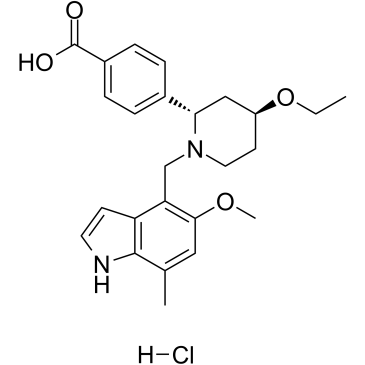LNP023 hydrochloride
Modify Date: 2024-01-04 18:53:09

LNP023 hydrochloride structure
|
Common Name | LNP023 hydrochloride | ||
|---|---|---|---|---|
| CAS Number | 1646321-63-2 | Molecular Weight | 458.98 | |
| Density | N/A | Boiling Point | N/A | |
| Molecular Formula | C25H31ClN2O4 | Melting Point | N/A | |
| MSDS | N/A | Flash Point | N/A | |
Use of LNP023 hydrochlorideLNP023 hydrochloride is an orally bioavailable, highly potent and highly selective factor B inhibitor. LNP023 shows direct, reversible, and high-affinity binding to human factor B with a KD of 7.9 nM. LNP023 inhibits factor B with an IC50 value of 10 nM[1][2]. |
| Name | LNP023 hydrochloride |
|---|
| Description | LNP023 hydrochloride is an orally bioavailable, highly potent and highly selective factor B inhibitor. LNP023 shows direct, reversible, and high-affinity binding to human factor B with a KD of 7.9 nM. LNP023 inhibits factor B with an IC50 value of 10 nM[1][2]. |
|---|---|
| Related Catalog | |
| Target |
KD: 7.9 nM (factor B)[2] IC50: 10 nM (factor B)[2] |
| In Vitro | LNP023 demonstrates potent inhibition of alternative complement pathway (AP)-induced membrane attack complex (MAC) formation in 50% human serum (IC50 value of 130 nM)[2]. LNP023 exhibits excellent selectivity over other proteases affording IC50 values of >30 μM across a panel of 41 human proteases, including the AP protein factor D (>100 μM)[3]. |
| In Vivo | LNP023 (20-180 mg/kg; oral administration) prevents KRN (150 μL)-induced arthritis in mice and is effective upon prophylactic and therapeutic dosing in an experimental model of membranous nephropathy in rats[2]. LNP023 exhibits moderate half-lives (T1/2; Wistar Han rats 3.4 h, beagle dogs 5.5 h) and Cmax (Wistar Han rats 410 nM, beagle dogs 2200 nM) following oral administration (rat 30 and, dog 10 mg/kg)[3]. LNP023 exhibits terminal elimination half-lives (T1/2; Wistar Han rats 7 h, beagle dogs 5.6 h) due to high plasma clearance (8, and 2 mL/min/kg respectively combined with large volumes of distribution (2.3, and 0.6 L/kg respectively) following intravenous administration (rat 1.0 and, dog 0.1 mg/kg)[3]. Animal Model: C57BL/6 mice with KRN-induced arthritis[2] Dosage: 20, 60, and 180 mg/kg Administration: Orally gavaged; twice a day (b.i.d.) for 14 days Result: Blocked KRN-induced arthritis. |
| References |
| Molecular Formula | C25H31ClN2O4 |
|---|---|
| Molecular Weight | 458.98 |
| InChIKey | SEZXOFFLNHXEJE-CQERKEQDSA-N |
| SMILES | CCOC1CCN(Cc2c(OC)cc(C)c3[nH]ccc23)C(c2ccc(C(=O)O)cc2)C1.Cl |